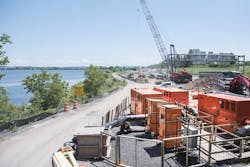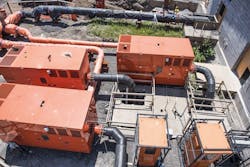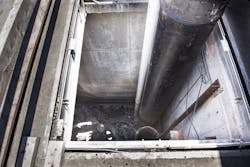About the author:
Darrin Ruiz is senior applications engineer for Xylem Dewatering solutions. Ruiz can be reached at [email protected].
When the West Side sewage pump station in Onondaga County, N.Y., prepared to undergo its first major expansion and upgrade in more than 30 years, the project required a bypass system to move a peak flow of 30 million gal per day (mgd).
C.O. Falter Construction was named the bypass contractor for the project and worked with Xylem to design and install a temporary system to convey the full amount of flow.
The West Side pump station is the second largest pump station in Onondaga County, taking in about 8 million gal of sewage per day from communities in the western suburbs, then pumping it to a nearby wastewater treatment plant. The expansion and upgrades to the West Side pump station would add more sewer capacity to help reduce sewage overflows into Lake Onondaga during heavy rains. The project would also expand the pump station’s capacity and increase its efficiency.
Careful Planning
While the initial design called for using the station’s existing pumps, during a plan review, Xylem calculated that the existing pumps would only bear 19 mgd of water.
During the initial evaluation, a design engineer thought there could be a cost savings in using the pumps already on hand, however, the original design failed to take into account for what the existing pumps were rated.
Accurate flow data and flow documentation is critical to properly size the bypass pumping system. If the anticipated peak flow is not determined correctly, the temporary bypass will not be able to sustain the sewer system during rehabilitation, and risks of contamination to the surrounding environment considerably increase as the possibility of a sewage spill becomes more likely.
After determining that the initial design missed the target by 25%, it became apparent that the job would require a temporary bypass system to meet the maximum flow capacity.
Tight Jobsite
The updated design called for a bypass system that stayed within the same footprint as the original pumps, which was limited.
To stay within the compact station area, Xylem used two Flygt N 3312 pumps that could plumb into the existing piping system, resulting in material cost savings for the customer.
Additionally, the pump station is located between Interstate 690 and Lake Onondaga. It also overlooks the New York State Fairgrounds, which hosts hundreds of events throughout the year. The area is a high visibility area and loud diesel equipment would not have been appreciated.
In addition to the two pumps, the bypass system installed by Xylem and C.O. Falter Construction at the West Side pump station included three Godwin Dri-Prime CD300M pumps. Housed in an acoustically silenced enclosure to minimize noise pollution, the attenuated units reduced pump noise levels to 69 decibels at 30 ft, meeting OSHA noise exposure standards. One Godwin CD300M pump was set up on grade and away from the construction area, with the other two diesel-driven pumps serving as backups.
Backup systems are essential in any bypass operation as they protect against instances of unexpected high flows or primary system failure during pipe rehabilitation. The combination of reliable primary pumps, supported by a robust backup system, offers peace of mind as service is guaranteed to be maintained during loss of power, whether from a scheduled outage or a natural disaster.
The combination of diesel pumps and electric submersible pumps allowed the temporary bypass to operate at maximum efficiency, offering a flexible solution for fluctuating wastewater flow levels.
The diesel pump model used for this project also has the capacity to handle solids up to 3.7-in. in diameter, allowing a range of slurries and fibrous materials to easily pass through the pump’s impeller and resist clogging.
The Godwin pumps were fitted with variable frequency drives (VFD), enabling operators to control the motor speed and reach the required duty point to ensure optimum operating efficiency throughout the project. On a similar note, each pump activated only when increased flows called for additional pump activity.
Real-Time Monitoring
The contractor and project owner required access to check that the system was running smoothly for the duration of the bypass, so an advanced remote monitoring and control panel was provided to continuously collect data from the VFD and transducer.
The bypass system went online in March 2018 and ran 24/7 through September 2018. It was set up to emulate the response and flows of the plant’s permanent equipment, and remote connectivity enabled the various parties involved in the project to continually monitor the pumps from any location using laptops, tablets and smartphones with internet access.
Adding remote monitoring capabilities reduced the need for onsite supervision and ensured the project ran without issue during the duration of the bypass.
The remote monitoring capability was helpful when the project was up and running, and fluctuations in the water flow varied due to the shifting student population at nearby Syracuse University.
Syracuse is a huge college town, so there were higher flows when school was in session, and capacity would drop in the summer. Because of this fluctuation, remote monitoring was a critical component of keeping the work on schedule.
With the ability to set parameters and alarms for minor issues, C.O. Falter Construction could address potential problems before an issue caused a major shutdown, optimizing manpower throughout the project.
Dan Falter, project manager for C.O. Falter Construction, said the ease with which anyone involved in the expansion and upgrade project could monitor the system in real time from remote locations was invaluable.
“It’s pretty slick,” Falter said. “If a pump goes down, we’re alerted even if we’re not on site. The remote monitoring capability provides peace of mind, which is everything.”
Along with flexibility and convenience, the remote monitoring and controls capabilities also proved more economical than staffing a worker to monitor the pump, which represented saving nearly $57,000.
A successful temporary bypass setup operated continuously for seven months while crews expanded and upgraded the pump station. This allowed the project owner and contractor to monitor flow rates and responses in real-time from any location.
A Trusted Partner
Renting the equipment versus the capital expenditure of purchasing it outright also provided a significant cost savings for Onondaga County. Pump rental solutions offer the flexibility to handle complex and evolving applications without having to invest in expensive pumping equipment that is not required on an ongoing basis.
A bypass of this size is not something you do every day, the pump supplier representative said. For larger projects, end users do not have justification for the cost of the pumps. Due to aging infrastructure and increased system demand, sewage bypass projects have become a critical component of many community investment projects to allow for necessary maintenance and repair.



